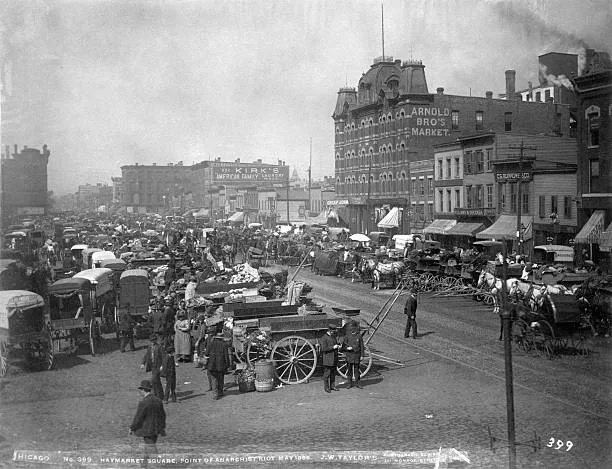Haymarket Riot | Cause, Effects, History
Haymarket Riot
 |
| Exterior view of the Randolph Street Haymarket Square: Point of the Anarchists Riot in May 1886, taken in Chicago, Illinois(Getty) |
On May 4, 1886, labor activists in Chicago, Illinois organized a protest advocating for an eight-hour workday. The protest, which began as a peaceful rally in Haymarket Square, turned violent when a bomb was thrown into the crowd, resulting in the deaths of both police officers and protesters.
The authorities quickly blamed the anarchist movement for the violence and arrested several labor leaders for inciting the riot. Despite a lack of evidence, eight men were convicted of murder and sentenced to death. However, the trial was heavily criticized for its bias against the defendants, who were later referred to as the "Haymarket Martyrs."
The Haymarket Riot brought significant attention to the labor movement and the struggles that workers faced in the United States. This event also served as inspiration for the creation of International Workers' Day, celebrated annually on May 1st as a symbol of workers' solidarity and perseverance.
Today, the Haymarket Riot is recognized as a crucial moment in the history of the labor movement and a symbol of the ongoing fight for workers' rights and social justice.
What was the Haymarket Riot and what was its effect?
In Chicago, Illinois, on May 4, 1886, a labor protest, also known as the Haymarket Affair, occurred. It started as a peaceful demonstration to support workers who were demanding an eight-hour workday, but violence erupted when a bomb was thrown into a group of police officers who had come to disperse the crowd.
Following the riot, eight labor activists, known as the Haymarket Martyrs, were controversially tried and executed. Despite the lack of definitive proof regarding who threw the bomb, the defendants were convicted of conspiracy and incitement to riot due to their political beliefs and association with the anarchist movement.
The Haymarket Riot had a significant impact on the labor movement and the wider political landscape of the United States. It became a symbol of the struggle for workers' rights and social justice, and was the inspiration behind the creation of International Workers' Day, also known as May Day, which is now celebrated in many countries worldwide.
The aftermath of the event resulted in a crackdown on the labor movement and the radical left, with many union members and activists being arrested and imprisoned. However, it also served as a rallying point for the cause of workers' rights and played a role in boosting the growth of the labor movement in the years that followed.
What did the Haymarket Riot cause?
The Haymarket Riot had significant consequences for both the labor movement and the overall political climate in the United States. Some of the main effects of the event include:
Crackdown on labor: In the aftermath of the Haymarket Riot, there was a crackdown on the labor movement and radical leftist groups. Many union members and activists were arrested and imprisoned, which had a chilling effect on the labor movement's ability to organize and advocate for workers' rights.
Creation of International Workers' Day: The Haymarket Riot became a symbol of the struggle for workers' rights and social justice, inspiring the creation of International Workers' Day (May Day), which is now celebrated in many countries worldwide.
Support for workers' rights: The event also helped to rally support for workers' rights, leading to the growth of the labor movement in the years that followed. The Haymarket Martyrs, who were executed after the event, became symbols of the fight for workers' rights and inspired others to join the cause.
Increased tensions between labor and management: The Haymarket Riot heightened tensions between labor and management and contributed to increased conflict between workers and employers. This tension persisted for many years and contributed to other labor disputes and strikes in the United States.
Overall, the Haymarket Riot had a significant impact on the labor movement and the broader political landscape of the United States. Its effects can still be felt today, with the struggle for workers' rights and social justice continuing to be an important issue.
Who was hung for the Haymarket Riot?
In connection with the Haymarket Riot, eight men were convicted of conspiracy and incitement to riot, and were subsequently sentenced to death by hanging. These men, known as the Haymarket Martyrs, were August Spies, Albert Parsons, George Engel, Adolph Fischer, Louis Lingg, Michael Schwab, Samuel Fielden, and Oscar Neebe.
Who started the Haymarket strike?
The Haymarket strike was a collective effort organized by the Federation of Organized Trades and Labor Unions, which eventually became the American Federation of Labor. The strike aimed to demand an eight-hour workday and was not instigated by any specific individual. On May 1, 1886, labor unions throughout the United States initiated a general strike to pressure employers into accepting their demand. The strike continued for several days, with numerous workers abandoning their jobs and taking part in demonstrations and gatherings. On May 4, 1886, the Haymarket Riot transpired at one of these rallies in Chicago.
What was one of the main effects of the Haymarket Riot?
One of the key outcomes of the Haymarket Riot was the clampdown on the labor movement and the radical left. Following the incident, numerous union members and activists were detained and imprisoned, thus hindering the labor movement's ability to mobilize and campaign for workers' rights. The incident also escalated tensions between labor and management, resulting in heightened conflicts between workers and their employers. However, the Haymarket Riot also acted as a catalyst for garnering support for workers' rights and contributed to the establishment of International Workers' Day, a holiday that is celebrated in various countries worldwide. Overall, the Haymarket Riot had a significant impact on the labor movement and the political scene of the United States.
Who was president during Haymarket Riot?
The Haymarket Riot occurred in 1886, during the presidency of Grover Cleveland.
What is a haymarket?
In general, a haymarket is a place where hay and other agricultural products are bought and sold. The term "Haymarket" can also refer to a specific location in Chicago, Illinois, where the Haymarket Riot of 1886 occurred. This location was a public square known as the Haymarket Square, where labor activists had gathered to protest police brutality against striking workers. The Haymarket Square is now known as the Haymarket Martyrs' Monument, which commemorates the labor activists who were killed or executed as a result of the riot.
What is the history of Haymarket?
The history of Haymarket is intertwined with the labor movement in the United States, particularly in Chicago, a major center of industry in the late 19th century. Many workers were employed in factories and other industries and experienced poor working conditions, long hours, and low wages.
In 1886, workers at the McCormick Harvesting Machine Company went on strike demanding better wages and working conditions. The strike quickly spread to other factories and industries, and by early May, thousands of workers were on strike.
On May 4, 1886, a protest rally against police brutality towards striking workers was held at the Haymarket Square. During the rally, a bomb was thrown at police officers attempting to disperse the crowd, killing several officers and civilians and injuring many others.
Eight labor activists were arrested and charged with conspiracy to commit murder following the bombing. The trial of these activists, known as the Haymarket Trial, was controversial and widely criticized for its lack of due process.
Despite international protests and appeals for clemency, four of the accused were executed, one committed suicide, and the remaining three were eventually pardoned. The Haymarket Riot became a symbol of the struggle for workers' rights and social justice and helped to fuel the labor movement in the United States. Today, the Haymarket Martyrs' Monument serves as a tribute to the activists who were killed or imprisoned as a result of the riot.





